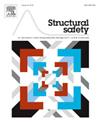基于虚拟建模的建筑物概率易损性评估的物理通知随机场技术
IF 6.3
1区 工程技术
Q1 ENGINEERING, CIVIL
引用次数: 0
摘要
为容易发生森林火灾的建筑物制定概率脆弱性评估框架是将森林火灾对生命安全和经济损失造成的风险降低到可接受水平的关键措施。一个可靠的评估方法应该包括多个基于概率的宏观指标,考虑到它们固有的不确定性。这些宏观指标可以包括特定时刻森林大火破坏的交通网络的效率、建筑物的地理位置等。提出了一种基于物理信息的随机场虚拟建模(PIRF-VM)框架,用于大规模林火事件中易发建筑物的脆弱性概率评估。PIRF生成了一个基于随机场的多物理信息融合模型,用于模拟大规模近似自然环境下的森林火灾蔓延。综合物理信息包括空间变化的植被特征、基于数字高程模型(DEM)的地形、地形形时变风场、道路和建筑物地理坐标。为了减轻pif中随机森林火灾模拟带来的计算负担,引入了虚拟机。它可以在输入物理信息和输出感兴趣的响应之间建立显式的函数关系,例如森林大火到达指定位置的剩余时间。因此,对于任何新的输入物理信息,可以直接预测输出响应,而无需耗时的模拟。受益于PIRF-VM的高效预测,在评估大规模林火事件中易发建筑物的概率脆弱性时,同时考虑了几个基于概率的宏观指标。澳大利亚Cowan社区作为一个例子,说明了所提出方案的实际应用,展示了在面对森林火灾危害时建设更具森林火灾弹性的社区的潜力。本文章由计算机程序翻译,如有差异,请以英文原文为准。
Physical-informed random field technique for virtual modelling based building probabilistic vulnerability assessment
Developing a probabilistic vulnerability assessment framework for bushfire-prone buildings is a critical measure to reduce bushfire-induced risks to life safety and economic losses to an acceptable level. A reliable assessment approach should include multiple probability-based macro indicators by considering their inherent uncertainties. These macro indicators can incorporate the efficiency of bushfire-damaged transportation network at specified moments, the geographical position of buildings, among others. A Physics-Informed Random Field-Virtual Modelling (PIRF-VM) framework for probabilistic vulnerability assessment of bushfire-prone buildings in large-scale bushfire incidents is proposed. The PIRF generates a random field-based, multi-physical information-fusion model for the simulation of bushfire spread in a large-scale approximate natural environment. The integrated physical information includes the spatially varying vegetation characteristics, the Digital Elevation Model (DEM)-based terrain, the terrain-shaped time-dependent wind field, the geographical coordinates of roads and buildings. To mitigate the computational burden posed by stochastic bushfire simulations in PIRF, the VM is introduced. It can establish an explicit functional relationship between input physical information and output responses of interest, such as the remaining time for bushfire reaching a specified location. As a result, for any new input physical information, the output responses can be directly predicted without time-consuming simulations. Benefiting from the efficient predictions of the PIRF-VM, several probability-based macro indicators are simultaneously considered when assessing the probabilistic vulnerability for bushfire-prone buildings in large-scale bushfire incidents. The Australian community of Cowan serves as an example to illustrate the practical application of the proposed scheme, demonstrating potential in constructing more bushfire-resilient communities in the face of bushfire hazards.
求助全文
通过发布文献求助,成功后即可免费获取论文全文。
去求助
来源期刊

Structural Safety
工程技术-工程:土木
CiteScore
11.30
自引率
8.60%
发文量
67
审稿时长
53 days
期刊介绍:
Structural Safety is an international journal devoted to integrated risk assessment for a wide range of constructed facilities such as buildings, bridges, earth structures, offshore facilities, dams, lifelines and nuclear structural systems. Its purpose is to foster communication about risk and reliability among technical disciplines involved in design and construction, and to enhance the use of risk management in the constructed environment
 求助内容:
求助内容: 应助结果提醒方式:
应助结果提醒方式:


